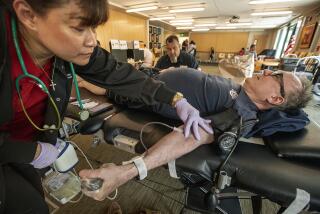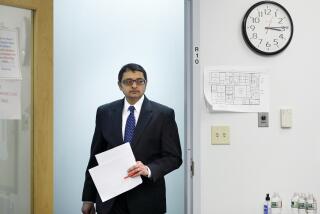Red Cross Outlines Speed, Safety of New Blood System
- Share via
SAN DIEGO — A new centralized blood testing system will make it easier to cope with any successor to the AIDS virus as the most-feared potential contaminant in the U.S. blood supply, officials of the American Red Cross said Monday.
Elizabeth Hanford Dole, former U.S. transportation secretary and now Red Cross president, outlined a system, announced on Sunday, that will centralize testing, record-keeping and oversight on the 10 million pints of blood the Red Cross collects every year.
“Instead of continuing to patch and bandage a system that evolved in the 1940s, we will move to the next generation,” Dole said. “Because of the AIDS epidemic, nothing short of a transformation is needed.”
In detailing the new system at the annual Red Cross convention, Dole thanked government officials for criticisms that catalyzed the Red Cross into action.
One critic, Rep. John Dingell (D-Mich.), held hearings last July questioning the safety of the nation’s blood supply because of clerical errors at Red Cross blood banks. The U.S. Food and Drug Administration repeatedly cited Red Cross blood centers over the last year for such problems.
The Red Cross, which handles about half the nation’s blood supply, adopted new quality control procedures last August, but the results were not enough of an improvement, said Dr. Jeffrey McCullough, the organization’s senior vice president for blood services. Both McCullough and Dole have assumed their posts since last summer.
The proposed changes will allow nationwide quality control and speedy action that have been difficult to achieve, McCullough added.
“We’re going to design and implement the blood bank of the future,” McCullough said, “so that the next time there’s a new virus that’s found, we can put that test in place promptly and inexpensively in every one of our centers.
“If we only have to put the test in eight laboratories and they all are on the same computer, and they use the same procedures, we can do it in a matter of days.”
Key to the plan, officials said, is having no more than 10 regional facilities for testing blood collected at the group’s 53 blood centers throughout the United States. Currently, each collection center does its own testing for seven different diseases, including AIDS and hepatitis.
The Red Cross board of governors voted to spend up to $120 million over the next 2 1/2 years for these changes.
By October, the agency plans to identify those blood centers that will be shut for eight weeks for re-equipping. Temporary closures of the remaining centers will follow in phases, but not before next January.
It is not known whether the first group will include the Los Angeles and Orange County branch, which plans to collect about 185,000 pints of blood this fiscal year, said spokeswoman Barbara Wilkes.
The only other Red Cross blood center in California is in San Jose, she said.
Nationwide, size was one reason it had been difficult for Red Cross to cope with the screening violations that the FDA found, McCullough said. These included mislabeling of tainted blood as safe.
“If you have to (correct such problems) in 53 places with 53 sets of computers, it takes months and hundreds of thousands of dollars to do it,” he said.
A central computer system--which officials will begin installing in January--will also give the Red Cross a better way to keep track of donors and the blood they donate, McCullough said.
The nation’s independent blood banks, which collect the other half the nation’s blood supply, might also benefit from the proposed changes. The 2,400 hospital and community blood banks across the country--which operate separately from the Red Cross--eventually might be able to participate in such a donor record system, said Jeffrey Solomon, chief of the American Assn. of Blood Banks, which represents the independents.
Until recently, Red Cross and the smaller independent blood banks have operated separately, and sometimes, in competition.
“I think the old ‘wars’ of the ‘40s, ‘50s, ‘60s and ‘70s are over. They ended with AIDS,” said Solomon, speaking by telephone from his Arlington, Va., office. “It’s just about time for all of us to pull together as a single group. I think we can help each other.”
The association has agreed to help make up for blood that Red Cross centers will not be collecting during the phased shutdowns, he noted.
Both McCullough and Solomon agreed that the U.S. blood supply is as safe as current testing technology will allow.
The recent advent of a test for previously undetectable hepatitis C has cut the number of transfusion-associated hepatitis cases from 10% to about 1%, Solomon said.
With AIDS, the major problem is the estimated 1 in 150,000 pints of blood that come from people who acquired the AIDS virus too recently for current tests to detect.
More to Read
Sign up for Essential California
The most important California stories and recommendations in your inbox every morning.
You may occasionally receive promotional content from the Los Angeles Times.









